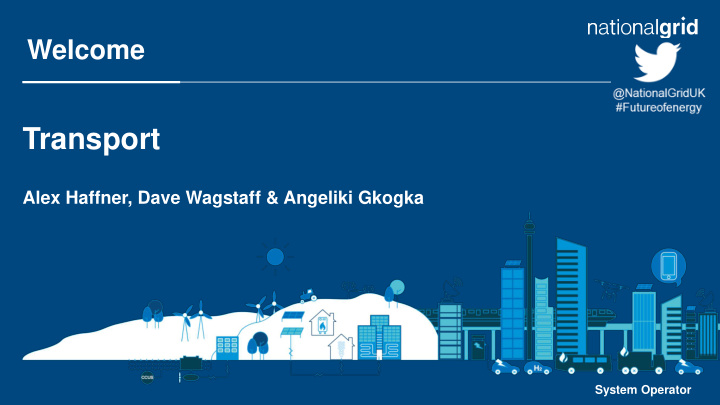



Welcome Transport Alex Haffner, Dave Wagstaff & Angeliki Gkogka System Operator
What we will cover today… • Recent changes in transport sector Internal combustion engine reductions • Annual energy demand from road transport • • Smart charging and engagement • Questions
Recent developments…
Transport – Numbers of ICE vehicles FES 2017 ICE vehicles at 2050 “Slower decarbonisation” scenarios still have ~12% ICE vehicles Car market saturates with EVs prior to 2040 in “faster decarbonisation” scenarios
Transport – Annual electricity demand 100 90 80 Annual demand (TWh/year) 70 60 50 40 30 20 10 0 2015 2020 2025 2030 2035 2040 2045 2050 Community Renewables Two Degrees Steady Progression Consumer Evolution
Transport – Annual Demand Hydrogen Natural gas Electricity Petrol/Diesel
Smart charging - 2040 winter’s day
Smart charging and engagement 100% 90% 80% 70% Engagement 60% 50% 40% 30% 20% 10% 0% 2015 2020 2025 2030 2035 2040 2045 2050 Community Renewables Two Degrees Steady Progression Consumer Evolution
Non-residential charging 67% of houses have off-road parking; what about the other 33% of houses? On the street At a destination In a charging forecourt ….and possibly a few more options….
Welcome Electricity supply & demand Andy Dobbie, Rob Nickerson & Mark Perry System Operator
Total peak demand 90 85 Total peak demand (GW) Faster take-up of electric vehicles 80 in 2050-compliant scenarios 75 70 65 Impact of smart charging reduces peak demand in the 60 2050-compliant scenarios 55 2005 2010 2015 2020 2025 2030 2035 2040 2045 2050 Community Renewables Two Degrees Steady Progression Consumer Evolution
Installed generation capacity 2017 2030 2050 300 65% 44% Installed capacity (GW) 250 37% 56% 200 45% 31% 28% 40% 150 27% 100 50 0 2017 CR TD SP CE CR TD SP CE Interconnectors Biomass CCS Waste Gas Coal Hydro Marine Nuclear Offshore wind Onshore wind Solar Other thermal Other renewables Storage Vehicle to Grid
Generation output Community Renewables 500 300 Renewable generation accounts for Carbon intensity (gCO 2 / kWh) more than 75% of total output by 2030 400 240 Annual output (TWh) 300 180 200 120 100 60 0 0 2015 2020 2025 2030 2035 2040 2045 2050 Interconnectors Biomass CCS Waste Gas Coal Hydro Marine Nuclear Offshore Wind Onshore Wind Solar Other Thermal Other Renewables
Growth of flexibility by 2050 0 GW 10 GW 20 GW 30 GW 40 GW 50 GW Storage and SP CR 2017 vehicle to grid Interconnectors CE TD 2017 Gas TD CE 2017
Key insights Low carbon technologies Markets will need to adapt New business models will grow at pace
Welcome Gas supply & heat Neil Rowley, Usman Bagudu & Nigel Bradbury
FES 2018 gas supply and heat presentation
Residential heat: thermal efficiency High case: CR & TD Low case: SP & CE Band D Percentage Homes Band C Band B Band A
Residential heat: low-carbon technology 35 Millions CR TD SP CE Now 30 25 20 15 10 5 0 2017 2050 2050 2050 2050 Gas boiler Electric Others Hybrid heat pump gas boiler Hydrogen District Heat
Gas supply: demand requirements 940 TWh 739 TWh TODAY 2050 717 TWh 673 TWh 335 TWh CR TD SP CE Total GB demand (including exports)
Gas supply: energy volumes provided in 2050 0 bcm 10 bcm 20 bcm 30 bcm 40 bcm UKCS CE SP 2017 CE Norway CR SP 2017 TD CR SP CE Shale 2017 TD Green gas CE SP TD CR 2017 Continent & CE CR SP TD 2017 LNG System Operator
Gas supply: import dependency 2050 100% 90% 80% 70% 60% Import 50% 40% 30% 20% 10% 0% 2000 2005 2010 2015 2020 2025 2030 2035 2040 2045 2050 History CR TD SP CE
Recommend
More recommend